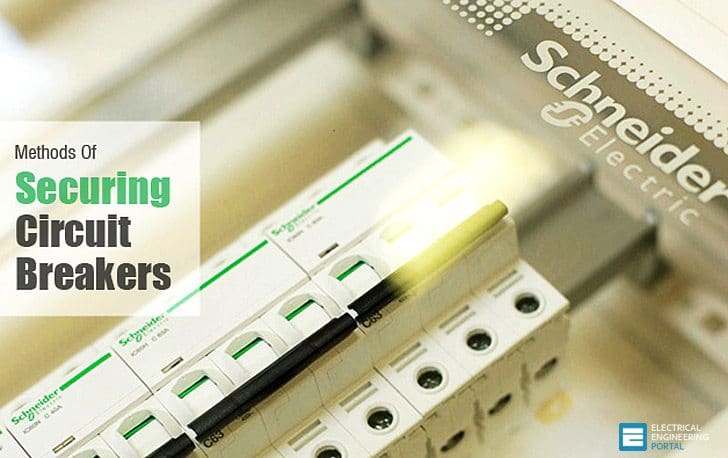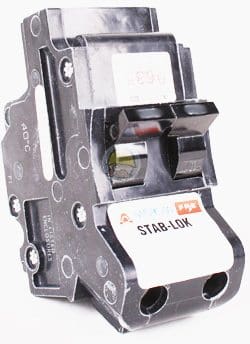
Methods
Circuit breakers are typically secured in place by one of the following methods:
- Through bolts
- Bolted to the bus
- Stab locked to the bus or some type of receptacle connection
- Din rail mounted
Bolted Type Breakers

When a longer service life breaker is wanted, a bolted type is typically used. These types have a metal tab (one for each phase) sticking out from one end that is bolted to the busbar with a machine screw (bolt type fine threads and not sheet metal screw type steep pitch threads).
It is not un-common for some individuals to initially determine that it is necessary to replace these types of breakers with power still applied to the busbars. I am not a big fan of working any thing above 12 volts hot, for I have witnessed too many good folks get hurt doing what was initially anticipated as being a quick and simple task.
When this type of breaker must be replaced with power still applied to the busbars, it should be done only under strict safety procedures; using proper personnel protective equipment and double insulated tools (every day plastic handle screwdrivers must not be used). A detailed job safety analysis should be conducted before any hot work is undertaken.
On more than one occasion I have witnessed some truly professionals conducting rehearsals of this type of activity several times until each safety step was done correctly. Take the time you need to be safe.
Stab Lock Type Breakers

This type of breaker employs a male-female type of plug & receptacle connection to a metal busbar on one end. The opposite end of the breaker is mated to the enclosure housing and does not make electrical contact with the busbar.
This small amount of breaker case movement is typically 1/8 of an inch or less on the busbar end. The circuit conductor termination lug may also exhibit some minor movement of the termination lug; again normally this movement is less than about 1/8 of an inch.
Din Rail Mounted Breakers

With this method, a mounting rail is secured to the enclosure and the breaker is snapped onto the mounting rail. This allows for replacement to be made quickly as the device can be un-clipped and a new one clipped on to the DIN rail.
Conductors for the supply and load are typically secured to the breaker using pressure connectors that are tightened by some type of threaded fastener.
These types of breakers are found in homes and light commercial applications installed in loadcenters. With this method of mounting some movement of the breaker is normal.
This small amount of breaker case movement is typically 1/8 of an inch or less on the busbar end. The circuit conductor termination lug may also exhibit some minor movement of the termination lug; again normally this movement is less than about 1/8 of an inch.
Reference: Electrical Circuit Breakers – L.W. BRITTIAN Mechanical & Electrical Instructor










